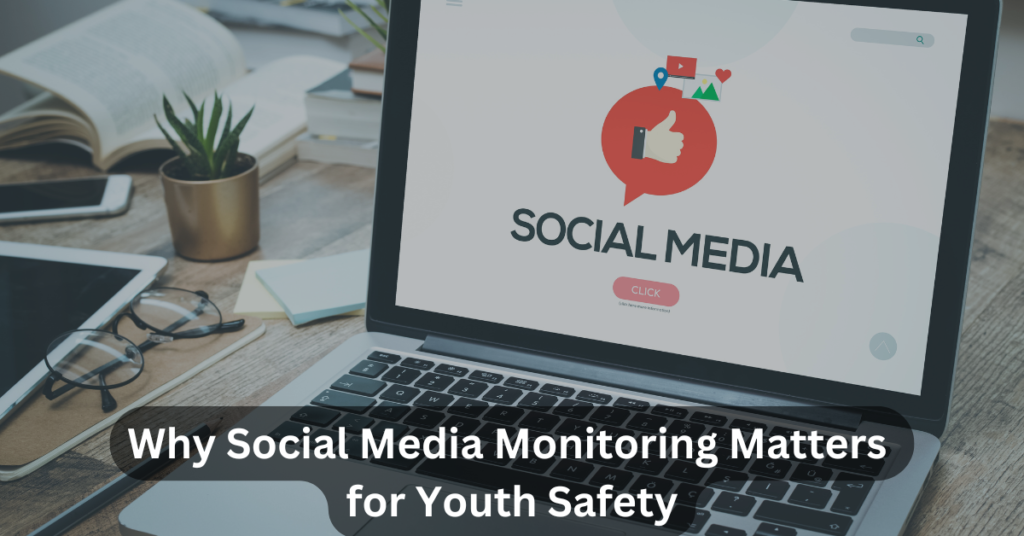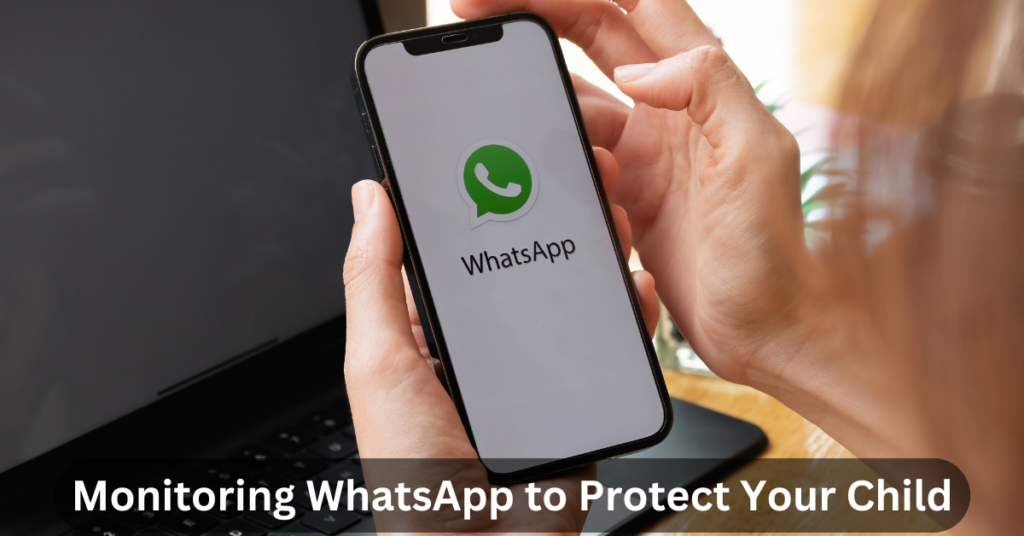Social media monitoring means keeping track of what is said and shared on social media platforms like Facebook, WhatsApp, and Snapchat. This helps parents, schools, and even brands understand what is happening online. It involves watching social media activity, noticing trends, and sometimes responding to important issues.
Monitoring social media is important because it helps protect young people from dangers like cyberbullying, harmful content, and privacy risks. Many teens use social media every day, so understanding and managing their online activities can keep them safer.
In this article, we will explore what social media monitoring is, why it matters especially for teens, and the balance between benefits and risks. We will also look at popular apps and tools used for social media monitoring.
Quick Fact: 93% of U.S. teens use social media, spending an average of 4 hours and 8 minutes per day on these platforms.
Teen Social Media Habits: Platforms, Trends, and Risks
Teens today live in a hyper-connected world where Instagram, TikTok, Snapchat, and YouTube aren’t just apps—they’re social lifelines. Nearly one-third of teens report being online almost constantly, with girls gravitating towards TikTok and boys more often on YouTube. These platforms blend entertainment, creativity, and socializing, but they also present complex challenges.
Quick Fact: About 55-61% of teens use Snapchat regularly, enjoying the appeal of disappearing snaps and playful filters, while Facebook’s popularity among youth has sharply declined, replaced by newer platforms that emphasize visual content and immediacy.
The risk lies in how teens navigate these spaces. Private chats, like those on WhatsApp, offer intimacy but can become channels for cyberbullying or sharing inappropriate content. Public-facing posts invite comparison and pressure, fueling anxiety and self-esteem struggles. The disappearing nature of Snapchat snaps might encourage candidness—sometimes with lasting consequences.
Did You Know? One-third of teens use at least one social site almost constantly
The Digital Pulse of Teens: Social Media Trends in 2025
TikTok, Instagram, and Snapchat dominate teen social media use, with many teens visiting these platforms daily or almost constantly. YouTube leads as the most widely used platform overall, but Facebook has declined in teen popularity. Daily use reflects a mix of entertainment, socializing, and creativity, with some teens using multiple platforms throughout the day. Gender and race also influence patterns: girls tend to use TikTok more intensely, while boys prefer YouTube. Overall, one-third of teens report using at least one popular social media site almost constantly, reflecting the deep integration of these platforms into their daily lives.
Read about: Beyond the News Feed: How to Keep Teens Safe on Facebook
The Bright Side: How Social Media Empowers Teens
- Connectivity: Social media helps teens stay connected with friends and family no matter where they are. Platforms like Facebook, WhatsApp, and Snapchat make it easy for teens to chat, share updates, and maintain relationships.
- Creativity: Social media offers teens many ways to express themselves creatively. They can share photos, videos, art, music, and more through posts and Stories. Using various apps, teens develop skills in digital photography, video editing, and graphic design, which are valuable for both personal expression and future careers.
- Support Networks: Teens can find communities and groups on social media that share their interests and experiences. Whether it’s hobbies, fandoms, or support groups for mental health, these online spaces help teens feel a sense of belonging and acceptance, which is crucial for their emotional growth.
- Educational Resources: Social media is a rich source of information and learning. Teens use social media to discover new facts, follow current events, explore different cultures, and even participate in online courses. It broadens their horizons and encourages curiosity and lifelong learning.
- Empowerment and Identity Development: Social media gives teens a platform to explore and develop their identities. By sharing thoughts and receiving feedback, they can experiment with different parts of their personality, gain confidence, and connect with others who accept them. This safe space for self-expression supports teens in forming a coherent sense of self during an important stage of life.
Social media is much more than just entertainment for teens. When used wisely and monitored thoughtfully by parents and schools, it can be a powerful tool for social connection, creative growth, emotional support, and education.
Alert: 48% of teens say social media has a mostly negative effect on their generation.
Read about: Beyond Blue Ticks: Monitoring WhatsApp to Protect Your Child
The Dark Side: Risks Teens Face on Social Media
Social media can bring many challenges for teens. Some of the most common problems and dangers include:
- Cyberbullying
Teens may face bullying online in the form of hurtful messages, threats, or public humiliation. The anonymity of social media sometimes makes this behavior worse. - Exposure to Harmful Content
Teens can accidentally see violent, inappropriate, or disturbing content, which may affect their emotional health. - Privacy Risks
Sharing personal information can lead to privacy breaches. Online predators may misuse this information to gain trust and cause harm. - Mental Health Effects
Anxiety and depression are common among teens who spend a lot of time on social media. Social media can negatively impact self-esteem, especially when teens compare themselves to idealized images. Excessive use often disrupts sleep patterns, leading to poor sleep quality and fatigue.
- Misinformation
False information spreads quickly on social media, which can mislead teens and influence their decisions in harmful ways. - Online Predators and Social Pressure
Predators may exploit teens’ trust, and social pressures can push teens toward risky behavior or sharing uncomfortable content.
Smart & Safe: Practical Tips for Teen Social Media Safety
To help teens stay safe online, the following safety measures are important:
- Use Privacy Settings: Teach teens to adjust privacy controls on social media platforms to limit who can see their posts and personal details.
- Increase Digital Literacy: Educate teens on how to spot misinformation, recognize online risks, and understand how social media works.
- Set Clear Rules and Limits: Encourage reasonable daily screen time limits. Establish tech-free zones or times, such as during meals or before bedtime. Monitor social media use with respect and open communication rather than spying.
- Promote Open Communication: Encourage teens to talk about any uncomfortable or harmful experiences they encounter online.
- Social Media Safety Education: Schools and parents should provide information on respectful behavior, online safety, and mental health awareness.
Read about: Snaps That Disappear, Risks That Don’t: Why Snapchat Needs Monitoring
Social Media Monitoring Tools: How They Work and Why They Matter
Social media monitoring software and apps are digital tools designed to help parents and schools track and manage teens’ activities on social media platforms. They typically:
- Track messages, posts, comments, and chats on popular platforms like Facebook, Snapchat, WhatsApp, Instagram, and TikTok.
- Monitor web browsing history and app usage.
- Detect risky behaviors such as cyberbullying, exposure to harmful content, and sharing of personal information.
- Provide alerts for concerning activities.
- Sometimes offer screen time controls and location tracking.
These tools enable caregivers to understand how teens use social media and intervene if necessary to ensure their safety online.
Callout: Kids on YouTube are most likely to be cyberbullied (79%), followed by Snapchat (69%) and TikTok (64%).
“Children and adolescents who spend more than 3 hours a day on social media face double the risk of mental health problems.”
Top Monitoring Tools Every Parent and School Should Know
Some of the leading apps and software tools used for social media monitoring include:
| App/Software | Features | Notes |
| FamiGuard | Tracks messages, notifications, visual screenshots from social apps, records calls on WhatsApp/Skype/etc., checks YouTube & TikTok history, limits app use | No device rooting needed, real-time sync, broad app coverage |
| Bark | Scans texts, emails, and 30+ social media platforms using AI detection for bullying, self-harm, and other threats, sends real-time alerts | Advanced AI-powered alerts and expert guidance |
| Qustodio | Monitors messages, social media activity, screen time, blocks inappropriate content, tracks location, sends daily reports | Includes time limits and parental controls for app/website use |
| XNSPY | Provides detailed activity logs including deleted messages, monitors conversations on social media, screenshots, tracks Tinder and YouTube activity | Useful for deep monitoring but privacy laws apply |
| Mobicip | Monitors Facebook, Snapchat, offers content filtering, screen time management | Good for child-friendly browsing and app use control |
Parents and schools rely on these tools to gain visibility into teens’ online behavior, detect potential risks early, and promote safer social media use.
Why Monitoring Teens Online Isn’t as Easy as It Sounds
Parents face a range of difficulties when trying to monitor social media:
- Rapidly changing platforms and trends: Teens quickly move from one app to another, making it hard for parents to keep up.
- Privacy concerns: Parents want to protect their child’s privacy while also ensuring safety, creating a delicate balance.
- Technical challenges: Monitoring requires some tech proficiency, and many parents are less familiar with the apps and tools teens use.
- Trust and relationship dynamics: Excessive or covert monitoring can damage trust, causing teens to hide more.
- Volume of data: Social media generates extensive activity and content, which can be overwhelming for parents to track and interpret.
Because of these challenges, parents often try to use a combination of monitoring tools along with open communication and education about safe social media use.
Privacy vs. Protection: Finding the Right Monitoring Balance
- Parents and schools must balance respect for teens’ privacy with the need to keep them safe.
- Open communication and transparency about monitoring policies help teens understand why monitoring is in place and reduce feelings of mistrust.
- Ethical monitoring involves focusing on public activity and discussions rather than invasive spying into private messages unless there is clear cause for concern.
- Monitoring should evolve as teens grow—starting with more oversight in pre-teen years and gradually shifting toward supporting teens’ digital autonomy and self-regulation.
Pros and Cons of Social Media Monitoring
| Pros | Cons |
| Early Detection of Issues: Helps parents and schools identify cyberbullying, mental health struggles, or risky behavior before serious harm occurs. | Potential Trust Issues: Over-monitoring or secretive spying can damage parent-child trust and lead teens to hide activities. |
| Protection from Cyber Threats: Monitoring tools can block harmful content, detect predators, and prevent exposure to inappropriate material. | Privacy Invasion: Teens may feel their privacy is violated, especially if monitoring extends to private messages without consent. |
| Improved Communication: Active monitoring encourages open dialogue about internet safety, habits, and digital literacy, strengthening relationships. | Technological Limitations: No monitoring tool is perfect—teens can find ways around software, and some apps miss harmful content. |
| Screen Time and Content Control: Parental controls help set healthy screen time and filter out unsuitable content, promoting better social media safety. | Dependency on Technology: Parents might rely too heavily on apps and neglect meaningful communication, which is crucial for monitoring to be effective. |
Social media monitoring plays an important role in keeping teens safe as they make their way through the complex world of online communication. By understanding what social media monitoring is and why it matters, parents, schools, and caregivers can better protect teens from the dangers of social media, such as cyberbullying, harmful content, privacy risks, and mental health challenges.
However, monitoring should be balanced with respect for teens’ privacy and trust. Open communication, clear rules, digital literacy education, and ethical use of monitoring tools are key to promoting social media safety. Schools and parents each have unique roles in this effort, working together to support healthy social media use.
Looking ahead, as social media platforms and trends continue to evolve, adapting monitoring approaches and fostering awareness will remain essential to safeguard youth and empower them to use social media positively and responsibly.


